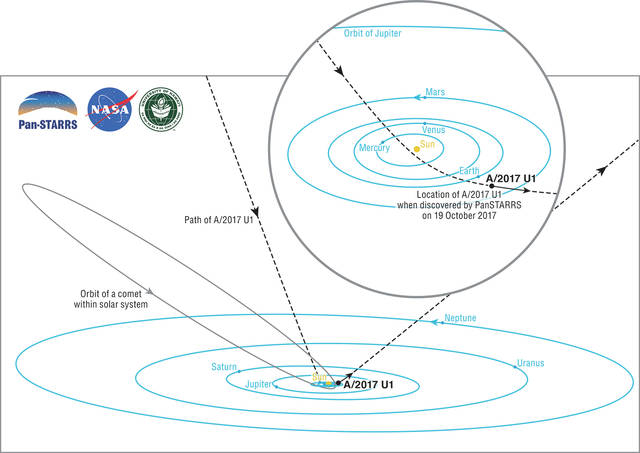A visiting space ship from another galaxy? Little green men? ADVERTISING A visiting space ship from another galaxy? Little green men? Most likely not. But a University of Hawaii astronomer discovered what appears to be the first near-Earth space object
A visiting space ship from another galaxy? Little green men?
Most likely not. But a University of Hawaii astronomer discovered what appears to be the first near-Earth space object to have arrived here from beyond our solar system, the university announced Wednesday.
“It was definitely very odd,” said Rob Weryk, the Institute for Astronomy postdoctoral researcher who first spotted the interstellar visitor.
UH’s Institute for Astronomy has assembled a team of scientists now trying to figure out what exactly the object is.
So far, scientists have very little data that would help them describe the object, other than to say it’s small. They also said they don’t believe it’s any kind of spacecraft from a far-off galaxy, judging from its orbit.
Whatever it is, the object already appears to be moving on its way out of the solar system and unlikely to return, according to Davide Farnocchia, a scientist at NASA’s Center for Near-Earth Object Studies at the agency’s Jet Propulsion Laboratory in Pasadena, Calif.
Weryk, a UH postdoctoral researcher, first saw the object late Oct. 18 during the course of his nightly search for near-Earth objects for NASA at UH’s Pan-STARRS telescope on Haleakala.
At first, he thought it was just another near-Earth object, he said, but then he searched for it in the data collected from the previous night’s Pan-STARRS scan and found it in an unusual place in the sky.
“To me it didn’t make sense,” Weryk said, noting that its orbit was not consistent with a typical asteroid or comet. “Initially, I thought it was just bad data.”
But Weryk didn’t stop there. He contacted colleague Marco Micheli, an IfA graduate, who also analyzed follow-up images taken at the European Space Agency’s ground station in the Canary Islands.
With the combined data, everything pointed to an object being from outside the solar system, Weryk said.
The object has been assigned the temporary name A/2017 U1 (PANSTARRS) by the Minor Planet Center, the International Astronomical Union’s office responsible for the identifying and designating of minor planets, comets and other natural satellites in space.
Because this is the first object of its type discovered, rules for naming don’t exist and will need to be established by the International Astronomical Union, officials said.
Scientists said A/2017 U1 approached the solar system at great speed from almost directly “above” the ecliptic — the path the planets, sun and moon follow — avoiding any close encounters with any of our eight planets.
On Sept. 2, it crossed the ecliptic plane inside of Mercury’s orbit and made its closest approach to the sun a week later.
The object made a hairpin turn under the influence of the sun’s gravity, they said, and then passed under the Earth’s orbit Oct. 14 at a distance of 15 million miles, or about 60 times the distance to the moon.
It is now moving above the plane of the planets, traveling at 27 miles per second and heading away from the Earth and the sun on its way back out of the solar system.
Weryk said the object was moving so fast, he thought it was closer to the Earth than it really was — which was about 30 million miles away, or about the equivalent of a third of the way to the sun.
“It didn’t look like the way other asteroids and comets look,” he said, recalling his initial analysis of the data.
UH astronomer Karen Meech said about 10 UH scientists are now scrambling to collect more data before the object becomes too faint in about a week. But getting telescope time on short notice is not easy, she said, so the team is trying its best.
Once all the data is collected, scientists will analyze things such as the object’s brightness and how much light is reflected from it, among other things, Weryk said. Those and other characteristics will provide some clues as to what it’s made of.
Meech, who specializes in small bodies and their connection to solar system formation, said scientists have long suspected that these objects should exist. During the process of planet formation, a lot of material is ejected from a solar system. In our solar system, the Oort cloud and Kuiper belt are full of cast-off comets.
“What’s most surprising is that we’ve never seen interstellar objects before,” she said.
Meech declined to speculate about what the object is made of.
“It’s probably something tossed out,” she said, adding that its composition likely depends on the chemistry of the galaxy it came from.
As to the possibility it is a space ship, she said its orbit and movement “looks extremely consistent with what a natural object looks like.”



